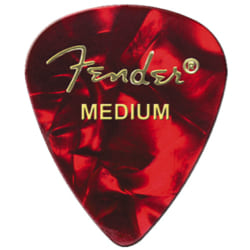Last Updated on July 22, 2023 by Justin
When it comes to modern guitar pick materials, celluloid material was one of the first to be used as a synthetic material to create guitar plectrums.
Contents
- The Best Celluloid Guitar Picks
- 1) Fender Celluloid Guitar Picks
- 2) D’addario Celluloid Picks
- 3) Jim Dunlop Celluloid Picks
- 4) D’andrea Celluloid Picks
- 5) Boss Celluloid Picks
- 6) Pickboy Celluloid Picks
- What Are Celluloid Guitar Picks?
- History Of Celluloid Guitar Picks
- How Do Celluloid Picks Sound?
- How Do Celluloid Picks Feel?
- Downsides To Celluloid Plectrums?
- What Shapes & Gages Can I Get Celluloid Plectrums?
In this article, I’ll be reviewing my best celluloid picks. I will also be discussing all the frequently asked questions surrounding celluloid plectrums as well as giving an in-depth explanation of the sound, feel, tone, and overall characteristics of the material.
The Best Celluloid Guitar Picks
When it comes to buying the best celluloid picks, I always recommend going for a reputable brand. The reason is that there are a lot of very cheap celluloid picks on the market which are of terrible quality.
Reputable guitar pick manufacturers make much better celluloid guitar picks. Having said that, distinguishing celluloid picks between the pick manufacturers is very tough as they are all so similar.
Despite this, I will review the best celluloid plectrums I’ve used in my time playing guitar.
1) Fender Celluloid Guitar Picks
The picks by Fender are the most popular and widely used celluloid plectrum ever used. Whilst I don’t believe they were the first company to produce celluloid picks, they certainly are the most well-known.
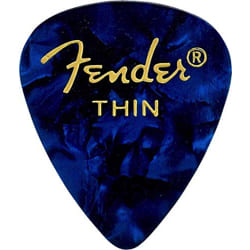 | Fender 351 Celluloid | |
 | Fender 346 Celluloid | |
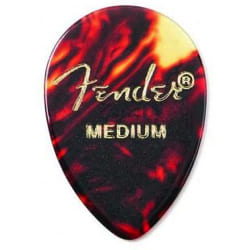 | Fender 358 Celluloid | |
 | Fender 355 Celluloid | |
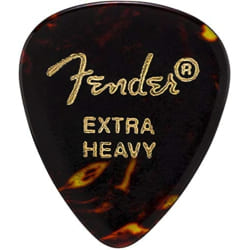 | Fender 451 Celluloid | |
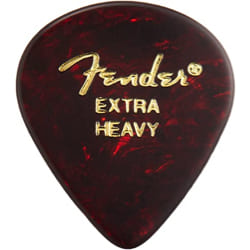 | Fender 551 Celluloid | |
 | Fender Thumb Pick Celluloid |
They come in three different gauges (thin, medium, and heavy) and you have a choice of the plectrum shapes as you can see above. They even come in thumb-pick and Finger-pick versions.
These picks have been used by some serious rock stars. Check out my list of the Top 10 best guitar picks to read more about the Fender celluloid plectrums.
2) D’addario Celluloid Picks
It is very hard to distinguish these D’addario celluloid picks from the Fender’s featured above. They are pretty much the same.
 | Daddario Standard Celluloid 0.50mm | |
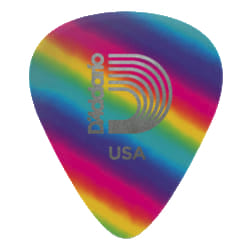 | Daddario Rainbow Celluloid0.70mm | |
 | Daddario Confetti Celluloid 1.00mm | |
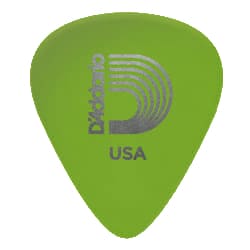 | Daddario Cellu-Glow 1.25mm |
However, the D’addario picks are only available in this regular shape whilst the Fender picks are available in a much wider variety of shapes. Having said that, there are plenty of color and design options when it comes to the Daddario celluloid plectrums.
3) Jim Dunlop Celluloid Picks
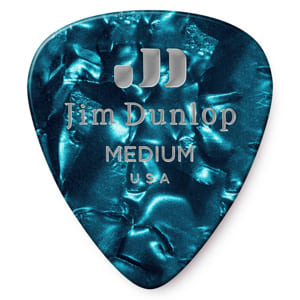
No great list of plectrums would ever be complete without a Jim Dunlop guitar pick in it. The reason is that it is such a historical company when it comes to manufacturing guitar picks.
Once again, it is very hard to distinguish the Jim Dunlop’s from either the fender or Planet Waves celluloid. One thing I can definitely say about the Dunlop celluloid picks is that they are available in an insane variety of different colors.
4) D’andrea Celluloid Picks
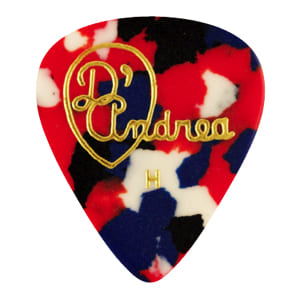
D’andrea was one of the first guitar pick manufacturers in the world and I could be wrong but I think they might have been the first company to produce celluloid guitar picks.
That makes this particular guitar pick an incredibly iconic piece of guitar-playing history. I don’t know much about D’andrea but from what I hear, they make fantastic guitar picks.
5) Boss Celluloid Picks

Boss, who is a company mostly known for its guitar pedals has recently come out with a range of celluloid picks. Boss stands for one thing and that is quality.
When they release a product you can be sure that they have done so with proper research and development so that they ultimately end up with a great quality product.
The same mentality has been adopted for the production of their celluloid picks but they are not very well known to the public at the moment. I am sure in time, these Boss guitar picks will grow in popularity.
These particular guitar picks have been featured in my list of bass guitar picks as their heavier selection seems to have gained quite a following amongst bass players.
6) Pickboy Celluloid Picks
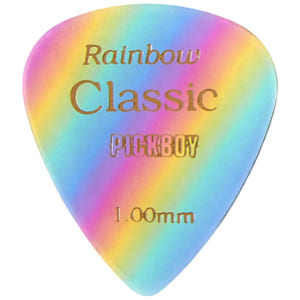
Pickboy is a guitar pick company that has been around for decades now. Despite being around since 1967, not many guitarists are aware of their existence. However, many professional musicians have been known to use the Pickboy classic celluloid in particular. These include guitarists such as John Mayer, Sid Griffin, and Tomo Fujita, just to name a few!
Pickboy is known for making high-quality guitar picks. And that is no different when it comes to these celluloid picks. As a fun fact, they were the original manufacturers of the rainbow pick.
What Are Celluloid Guitar Picks?
Celluloid is a synthetic plastic that is made by using a combination of camphor as well as nitrocellulose. To be completely honest, I do not have the knowledge to explain these materials in detail.
However, what I can tell you is that celluloid as a material for guitar picks is cheap to produce and also very easy to manipulate and mold. Coloring celluloid is also easy which is why we find celluloid plectrums in so many different colors.
Celluloid is also supposed to be strong material but when it comes to guitar picks I’d have to say that it is one of the least durable materials for picks. That being said, the celluloid picks changed rock n roll guitar playing for the good.
History Of Celluloid Guitar Picks
As I have already mentioned, this was one of the first synthetic materials to be used as a substitute for the illegal tortoiseshell. Celluloid material for guitar picks caught on exceptionally quickly as tortoiseshell became harder to acquire.
It is also for this reason that a lot of celluloid guitar picks are made to look like tortoise shell picks from back in the day. This was a very popular material for plectrums and guitarists enjoyed them a lot.
However, just like nylon suffered the Delrin material which is now probably the most popular plectrum material. That being said, celluloid picks remain very popular to this day and we can confirm this by the number of famous guitarists that use/used celluloid such as Jimi Hendrix, Stevie Ray, and David Gilmour.
How Do Celluloid Picks Sound?
To my ear, celluloid is definitely on the brighter side when it comes to tone along with its sharp attack. This is very often the same characteristic given to describe Delrin guitar picks.
However, these two materials are very different and will very often sound different from each other. In my opinion, celluloid produces more of a “plastic” attack whereas Delrin seems to produce a more natural attack.
Celluloid plectrums have never really been known for sounding the best but rather were mainly known for their similar flexibility to tortoiseshell.
I do believe that you can definitely achieve a softer and warmer tone with a celluloid pick simply by the way in which you strum or strike this string. I’d say the harder you strum, the brighter the tone becomes.
How Do Celluloid Picks Feel?
These picks can certainly be described as flexible. But in my opinion, I’d say celluloid is a little too flexible for my taste when it comes to the thinner gauges and a little too stiff for the heavier gauges.
For example, I find the light celluloid gauged guitar picks to be on the flappier side whilst the heavier gauges have little to no flex for my liking. It’s important to remember that that is only personal preference.
I’ve never been a fan of celluloid as a material for plectrums so it is no surprise that my review of how they sound and feel wouldn’t be as positive as perhaps someone that is a fan. Just remember, celluloid has been used by some of the biggest guitarists in the world so it is definitely worthwhile giving them a try.
You never know, they might be just what you’re looking for. Whilst these are definitely flexible, I find that nylon guitar picks are more on the flexible side.
Downsides To Celluloid Plectrums?
Celluloid tends to wear down quicker than most other plectrum materials out there. I also find that they have a tendency to break especially if you strike the guitar strings hard or pick at a specific area.
Even the heavier gauges tend to wear and break. Whilst this is common in most guitar picks, I tend to find that celluloid picks need a lot more replacing.
Whilst the celluloid picks are cheaper to buy, one should factor in that they break fairly regularly, and replacing them should be taken into account.
What Shapes & Gages Can I Get Celluloid Plectrums?
When it comes to the choice of gauges, celluloid guitar picks lack the variety that we’re generally used from other plectrum materials.
I am not sure what the reason for this is because celluloid is generally an easy material to produce and mold. You can expect to find celluloid picks in three gauges being; thin, medium, and heavy.
With regards to shapes, there are quite a lot to choose from. The most common celluloid pick shapes are:
- Regular
- Triangle
- Rounded-Triangle
- Teardrop

Hey, fellow guitar mate! I’m Justin, I have been a professional guitarist since 2012. I have traveled the world playing on different stages alongside some of the best indie bands, at some of the biggest music festivals in the world. As a result, I’ve played lots of different guitar gear. Instead of keeping that knowledge to myself, I have set up this site to share my honest reviews of various guitar gear. But most notably, my love for guitar picks.

